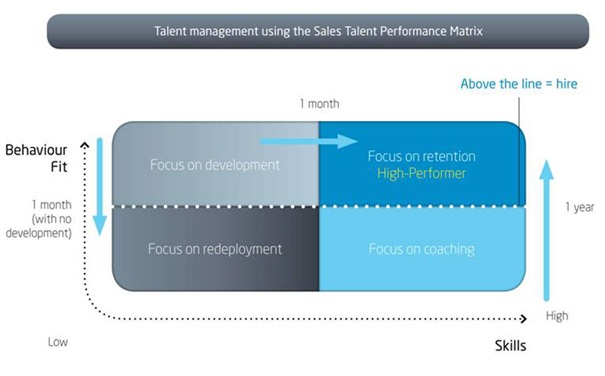Sales Force Focus - The Shared Development Journey
Marie Crespo explains how insight into your sales talent’s performance potential delivers a powerful sense of engagement and empowerment amongst employees.

‘Biopharma’s legacy commercial model has already started to evolve, with less emphasis on large sales forces “selling” to physicians; further changes are on the way. Information transparency will allow customers, regulators and competitors to understand the performance of biopharma products as well as, or even better than, the manufacturer does, as powerful new data sources reveal the efficiency of medicines in real-world settings.’ So says McKinsey as it sums up the revolution in the pharma sector and the industry’s response to the challenges this brings1.
What’s happening to pharma is not happening in isolation, of course. In fact, pharma has come rather late to the party: in the words of the McKinsey authors Sam Marwaha, Brian Milch and Steve Savas, ‘big data, social media and mobility are shaking up the models of many industries’. And what pharma is learning is that the status quo is unsustainable. Its commercial model is having to change dramatically: simply trying to sell more of the same, selling harder but in the same way, just won’t cut it anymore.
The authors point to three trends – data-based transparency, personalised care and consumer-directed care – which will combine to drive the move towards so-called ‘connected health’. Interestingly, these initiatives parallel innovations in the talent world, which are predicted to have a major effect on how organisations approach training and development in the future.
Just as a trend towards personalised care – the right treatment for the right patient at the right time – is emerging in the health sector, so a similar approach to talent management and development is beginning to take hold in the world of sales human capital management: and, clearly, both trends will have a major impact on pharma organisations and the way they shape and manage their sales organisations in future.
One of the key drivers in both trends is big data and the ability to drill down into issues to the most granular level. Pharma organisations with large numbers of sales resources have to manage an especially complicated sales talent management jigsaw, balancing hiring and retention decisions along with the need to optimise development ROI (return on investment).
The development journey
Effective sales talent assessment is the key to putting all the pieces together, with its ability to gather relevant data, identify significant competency gaps and facilitate a winning talent management strategy. Depending on how they are constructed, the most effective assessment tools are able not only to measure suitability for an existing role with considerable accuracy but also to predict potential or ‘headroom’ for a candidate to grow into a new role (or, indeed, the need for them to be redeployed into a more appropriate or less-challenging role).
This opens up the opportunity for creating a dynamic process whereby talent is developed for and deployed to suitable roles where they can perform at their best and be most productive. At the same time, the roles themselves can be continuously aligned to the needs of the marketplace.
This creates an immensely powerful opportunity to optimise talent for specific roles, to engage in succession-planning and to drive organisational change, while also maximising talent retention opportunities by ensuring that roles, talent, aspirations and competencies are well-matched.
Role-fit
We have mentioned the importance of role-fit before – illustrated by the familiar Sales Talent Performance Matrix (Figure 1). When hiring or positioning an individual for a specific sales role, high role-fit indicates potential for high-performance in the role, whereby high-performers deliver some 67% more revenue annually compared with the average.
Figure 1
Looking at this graphic, one can see that not only should development be aimed at those lacking relevant skills but it should also be focused on those with a good behavioural fit for the role, in order to ensure the best returns. This is because behavioural issues need to be approached through lengthy (and expensive) coaching interventions, whereas skills gaps can be addressed relatively swiftly through precisely targeted training and learning opportunities. Inevitably, this also implies that those with high skills but poor role-fit may be more suited behaviourally or intellectually for a different role.
Targeting development
In terms of targeting development, it is important to understand exactly where the competency gaps lie, at both an individual and team level. As Pierre Gurdjian and Oliver Triebel pointed out in the McKinsey Quarterly2, many training programmes don’t yield the desired results. One reason is that they are usually launched without sufficient knowledge of where the gaps in employees’ skills exist. Understanding where these gaps lie avoids costly repetition of training for employees who don’t need it (a big turn-off for salespeople) and also keeps downtime to a minimum. Clearly, the correct diagnosis should lead the prescription.
A development needs analysis is the starting point in terms of identifying where skills and competency gaps lie, which then needs to be translated into a programme that will deliver the greatest return or address the most pressing issues. Traditionally, such analyses have been time-consuming and costly undertakings if they are carried out with any degree of rigour. Furthermore, the cynics amongst us would point out that too often they are simply used by training companies as a way to sell more training: even worse, sometimes the analysis is skewed to fit the training products the company has available.
Luckily, once again an effective assessment programme offers us a solution to this problem: the best assessment products are designed to deliver a comprehensive development needs analysis for each candidate right out of the box. So then the challenge becomes one of converting this needs analysis into actionable, results-driven interventions.
One of the big issues is being able to understand the bigger picture – which competencies are missing or weak across the organisation or shared by several members of a team – without losing the ability to focus down on the individual. Again, with the best assessment products, relevant dashboards and analysis tools enable organisations to view the capabilities and potential of their sales talent on an individual, team, geographical or organisation-wide basis. Data can be cut by person or by competency, empowering organisations to build focused development strategies and to maximise the efficiency of the way skills training is delivered.
For organisations with their own academies, this level of insight enables companies to shape and deliver development programmes according to the gaps identified. Where there are common skills gaps across a team or the wider organisation, academies can tailor their output accordingly. And at an individual level, e-learning is a cost-effective way of delivering short, bite-sized pieces of training or advice on demand at a very granular level, or even providing customised development programmes for individuals.
The new insight created by accurate and comprehensive assessment of sales performance potential brings with it major benefits for employers: it lights the way for organisations to optimise development budgets by focusing development where it will deliver most return, and by enabling managers to focus development precisely when and where it is needed. This approach also brings motivational benefits for both the organisation and to individuals, who understand that their employer is not only making a substantial investment in them but is also aiming to avoid wasting their time with poorly conceived and repetitive development programmes. Such individuals tend to be more highly engaged.
Conclusion
The concept of a shared development journey – facilitated by an appropriate sales talent assessment tool – is very powerful, both for employee and employer. With motivation and engagement comes a sense of empowerment that employees can not only shape their own destiny but that of the organisation itself: as they develop, the organisation develops too. It has profound consequences for the way organisations formulate their talent retention strategies.
In our final article, we will look at how enlightened organisations are using this concept to imbue a sense of responsibility in their key employees and to drive their sales talent pipeline and retention strategies, whereby a sense of shared investment helps foster engagement and ‘ownership’.
References
1Biopharma in the coming era of ‘connected health’by Sam Marwaha, Brian Milch and Steve Savas, McKinsey & Co, 2012.
2‘Identifying Employee Skill Gaps’, by Pierre Gurdjian and Oliver Triebel, McKinsey QuarterlyMay 2009.


